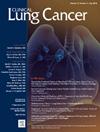Transarterial Embolization for the Management of Emergent Hemoptysis in Patients With Primary and Metastatic Lung Tumors
IF 3.3
3区 医学
Q2 ONCOLOGY
引用次数: 0
Abstract
Objectives
To evaluate the role of systemic arterial embolization in patients with primary and metastatic lung tumors presenting with hemoptysis requiring emergent management.
Patients and Methods
This retrospective single-center study evaluated patients undergoing transarterial embolization for emergent hemoptysis. Endpoints included technical success, clinical success and overall survival. Clinical success was divided into partial or complete, and defined as absence (complete) or subtotal (partial) reduction in frequency and/or volume of hemoptysis in the first 24-hours following embolization. Predictive factors for clinical outcomes were evaluated using univariate analysis. Adverse events were graded according to Common Terminology Criteria for Adverse Events (CTCAE) v5.0.
Results
Thirty-seven patients were identified, including 21/37 (56.8%) patients with primary lung cancer. Clinical success was achieved in 31/37 (83.8%) patients. Median overall survival was 18 days (95% CI, 10-95). Median hemoptysis-free survival was 270 days (95% CI 7 to not reached). No significant predictors of hemoptysis-free survival were identified. Prior chemotherapy (HR 2.69, 95% CI, 1.08-6.67; P = .03) was associated with poorer overall survival. History of primary lung tumor (vs. metastatic tumor) was associated with improved overall survival (HR 0.45, 95% CI, 0.21-0.95; P = 0.04). No serious adverse events (CTCAE Grade ≥ 3) were found to be directly attributable to the embolization.
Conclusion
Hemoptysis requiring emergent management in patients with lung malignancy carries a poor prognosis. Transarterial embolization is feasible, safe and may be an effective management option, although further research is warranted to identify which patients are likely to derive the greatest benefit.
经动脉栓塞治疗原发性和转移性肺肿瘤患者的紧急咯血。
目的:评价全身性动脉栓塞在原发性和转移性肺肿瘤伴咯血需要紧急治疗的患者中的作用。患者和方法:本回顾性单中心研究评估了经动脉栓塞治疗急诊咯血的患者。终点包括技术成功、临床成功和总生存期。临床成功分为部分或完全,并定义为栓塞后24小时内咯血频率和/或体积减少(完全)或次全(部分)减少。采用单因素分析评估临床结果的预测因素。根据不良事件通用术语标准(CTCAE) v5.0对不良事件进行分级。结果:37例患者中有21/37(56.8%)为原发性肺癌。临床成功率为31/37(83.8%)。中位总生存期为18天(95% CI, 10-95)。无咯血的中位生存期为270天(95% CI为7至未达到)。没有发现无咯血生存的显著预测因子。既往化疗(HR 2.69, 95% CI, 1.08-6.67;P = .03)与较差的总生存率相关。原发性肺肿瘤病史(相对于转移性肿瘤)与改善的总生存率相关(HR 0.45, 95% CI, 0.21-0.95;P = 0.04)。未发现与栓塞直接相关的严重不良事件(CTCAE分级≥3)。结论:肺恶性肿瘤患者咯血需急诊治疗预后较差。经动脉栓塞是可行的,安全的,可能是一种有效的治疗选择,尽管需要进一步的研究来确定哪些患者可能获得最大的益处。
本文章由计算机程序翻译,如有差异,请以英文原文为准。
求助全文
约1分钟内获得全文
求助全文
来源期刊

Clinical lung cancer
医学-肿瘤学
CiteScore
7.00
自引率
2.80%
发文量
159
审稿时长
24 days
期刊介绍:
Clinical Lung Cancer is a peer-reviewed bimonthly journal that publishes original articles describing various aspects of clinical and translational research of lung cancer. Clinical Lung Cancer is devoted to articles on detection, diagnosis, prevention, and treatment of lung cancer. The main emphasis is on recent scientific developments in all areas related to lung cancer. Specific areas of interest include clinical research and mechanistic approaches; drug sensitivity and resistance; gene and antisense therapy; pathology, markers, and prognostic indicators; chemoprevention strategies; multimodality therapy; and integration of various approaches.
 求助内容:
求助内容: 应助结果提醒方式:
应助结果提醒方式:


